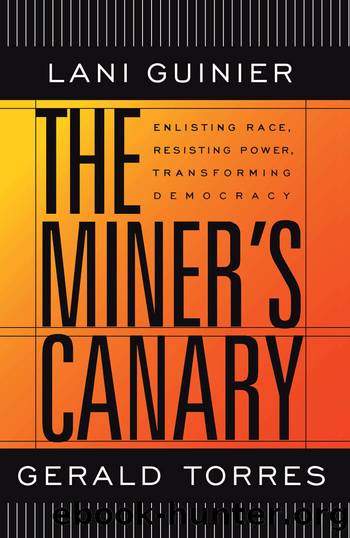The Miner's Canary: Enlisting Race, Resisting Power, Transforming Democracy by Lani Guinier & Gerald Torres

Author:Lani Guinier & Gerald Torres [Guinier, Lani & Torres, Gerald & Guinier, Lani]
Language: eng
Format: epub
Tags: Discrimination, Civil Rights, Social Science, Political Science, History, Sociology, Politics, Law, Feminism
ISBN: 9780674038035
Google: U_TKWtFdy9QC
Goodreads: 8309344
Publisher: Harvard University Press
Published: 2002-01-01T00:00:00+00:00
7
WHITENESS OF A DIFFERENT COLOR?
* * *
A series in the New York Times entitled âHow Race Is Lived in Americaâ focused on two Cubans, one white and one black. They were best friends as boys in Cuba, but their lives took a disconcerting turn when they each emigrated separately to the United States.1 Their experience illustrates the difficulty of âliving on the hyphenâ in this country and the powerful pressures to conform to the black-white imperative of racial management. For Latinos, it also points toward a less visible but potentially more viable path over this racialized terrainâthrough a pan-ethnic Hispanic/Latino identity which would challenge not just the racial borders themselves but the underlying systems of wealth and power that the racial âborder patrolâ currently protects.2
Joel Ruiz and Achmed Valdez grew up together in Cuba. Though Joel was black and Achmed white, neither thought much about this difference when they were young. Racism was a feature of pre-revolutionary life in Cuba, and it had not been totally stamped out; but it did not seem to determine oneâs life chances there, and it did not stand in the way of friendship between the two boys. Their common identity as Cubans trumped divisions of race.
When Joel and Achmed grew up, they made independent decisions to leave their homeland. Each was apprehended by the U.S. Coast Guard and sent to Guantanamo before being allowed to enter Miami. Joelâs experience in Cuba had not prepared him for the way race matters in the United States. In Miami, Joel found a segregated city. Whereas Achmed went initially to Hialeah, the first stop for white Cubans, Joel went to the black ghetto of Liberty City. As the reporter, Mirta Ojito, put it: âThis was Miami, and in Miami, as the roughly 7 percent of the areaâs Cubans who are black quickly learn, skin color easily trumps nationalism.â
This point was driven home to Joel one night when a white Cuban-American policeman stopped and frisked him. Joel had been celebrating Valentineâs Day in a popular Cuban restaurant with his uncle and three women friends. The policeman said to him, âIâve been keeping an eye on you for a while. Since you were in the restaurant. I saw you leave and I saw so many blacks in the car, I figured I would check you out.â Though the officer used Spanish to communicate with Joel, the actual words he spoke drew a racial line between them that denied their common nationality. After that incident, Joel felt trapped. Though he still identified himself as Cuban, whites saw him as black, and blacks saw him as Cuban. âThey tell me Iâm Hispanic. I tell them to look at my face, my hair, my skin. Iâm black, too. I may speak different, but we all come from the same place.â
Joelâs experience of being named black by white Americans in a way that subordinated his Cuban-ness shows how the black-white boundary in the United States disciplines those who would challenge its impermeability. The white
Download
This site does not store any files on its server. We only index and link to content provided by other sites. Please contact the content providers to delete copyright contents if any and email us, we'll remove relevant links or contents immediately.
| Civil Rights | Discrimination |
| General | Human Rights |
Day by Elie Wiesel(2719)
The Age of Genius by A. C. Grayling(2544)
Gideon's Spies: The Secret History of the Mossad by Gordon Thomas(2304)
The Gulag Archipelago (Vintage Classics) by Aleksandr Solzhenitsyn(2047)
FATWA: Hunted in America by Pamela Geller(1971)
Columbine by Dave Cullen(1815)
Men Explain Things to Me by Rebecca Solnit(1691)
The Rule of Law by Bingham Tom(1651)
Anatomy of Injustice by Raymond Bonner(1619)
Examples & Explanations: Administrative Law by William F. Funk & Richard H. Seamon(1601)
Three Cups of Tea by Greg Mortenson(1576)
That Every Man Be Armed by Stephen P. Halbrook(1548)
The Source by James A. Michener(1535)
ADHD on Trial by Michael Gordon(1531)
Gideon's Spies by Gordon Thomas(1470)
Future Design by Unknown(1469)
Palestinian Walks by Raja Shehadeh(1459)
Constitutional Theory by Carl Schmitt(1413)
Nothing to Envy by Barbara Demick(1385)
